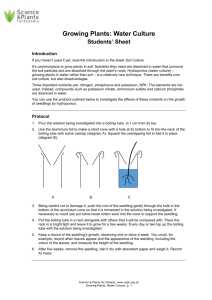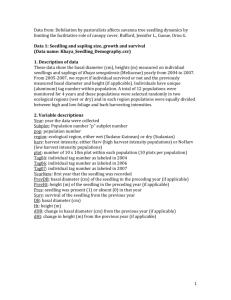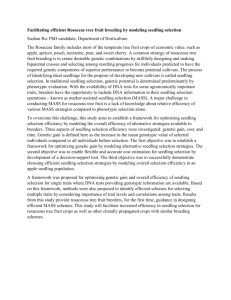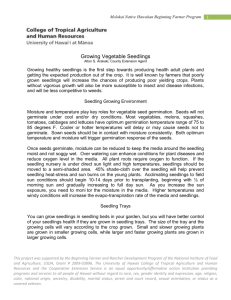Topic: Transport in Organisms
advertisement
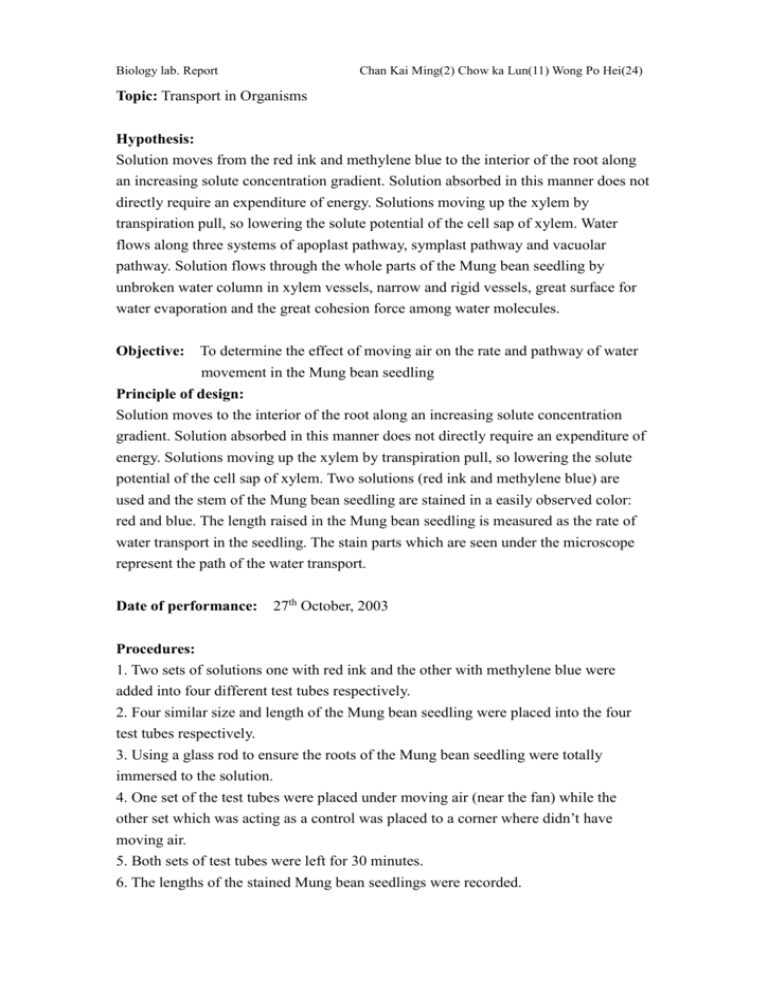
Biology lab. Report Chan Kai Ming(2) Chow ka Lun(11) Wong Po Hei(24) Topic: Transport in Organisms Hypothesis: Solution moves from the red ink and methylene blue to the interior of the root along an increasing solute concentration gradient. Solution absorbed in this manner does not directly require an expenditure of energy. Solutions moving up the xylem by transpiration pull, so lowering the solute potential of the cell sap of xylem. Water flows along three systems of apoplast pathway, symplast pathway and vacuolar pathway. Solution flows through the whole parts of the Mung bean seedling by unbroken water column in xylem vessels, narrow and rigid vessels, great surface for water evaporation and the great cohesion force among water molecules. Objective: To determine the effect of moving air on the rate and pathway of water movement in the Mung bean seedling Principle of design: Solution moves to the interior of the root along an increasing solute concentration gradient. Solution absorbed in this manner does not directly require an expenditure of energy. Solutions moving up the xylem by transpiration pull, so lowering the solute potential of the cell sap of xylem. Two solutions (red ink and methylene blue) are used and the stem of the Mung bean seedling are stained in a easily observed color: red and blue. The length raised in the Mung bean seedling is measured as the rate of water transport in the seedling. The stain parts which are seen under the microscope represent the path of the water transport. Date of performance: 27th October, 2003 Procedures: 1. Two sets of solutions one with red ink and the other with methylene blue were added into four different test tubes respectively. 2. Four similar size and length of the Mung bean seedling were placed into the four test tubes respectively. 3. Using a glass rod to ensure the roots of the Mung bean seedling were totally immersed to the solution. 4. One set of the test tubes were placed under moving air (near the fan) while the other set which was acting as a control was placed to a corner where didn’t have moving air. 5. Both sets of test tubes were left for 30 minutes. 6. The lengths of the stained Mung bean seedlings were recorded. Biology lab. Report Chan Kai Ming(2) Chow ka Lun(11) Wong Po Hei(24) 7. Stem of a well-illuminated piece of both sets of Mung bean seedling were cut into very thin species. 8. Species were observed under microscope. 9. Leaves of the both sets of Mung bean seedling were cut in a cut treated carrot by special technique. 10. Species of leaf were observed under microscope. Result Table: Seedling in the dyed water (red ink) Seedling in the dyed water (Methylene blue) Length increased (cm) 11.6 10.8 Rate of water transport (cm/min) 0.37 0.36 The table showing the rate of water transport in moving air condition Seedling in the dyed water (red ink) Seedling in the dyed water (Methylene blue) Length increased (cm) 8.3 7.9 Rate of water transport 0.28 0.26 (cm/min) The table showing the rate of water transport in still air condition ~The time taken is 30 minutes. ~The calculation of the above result is shown below: Length increased / time taken = rate of water transport Discussion: First of all, we obtain the stems of the Mung bean seedlings are dyed. This proves that the water was intake form the root to the stem by a force. This force is transpiration pull. The transpiration pull is introduced by the loss of the water vapour from the surface of the Mung bean seedling. Then the water is draw from the veins to the leaf. The rate of water transport is 0.366 cm/min in the moving air and that in still air is 0.26 cm/min. The rate of water transport in moving air is faster than that in still air. It is because the transpiration rate of the seedling in moving air is faster than that in still air. The water loss of the seedling becomes larger in the moving air. The faster rate of Biology lab. Report Chan Kai Ming(2) Chow ka Lun(11) Wong Po Hei(24) water loss, the faster rate of transpiration. The transpiration pull is later to draw more water form the vein (xylem) to the leaf for vaporization. Escaping water vapour decreases the relative humidity of the surroundings of the leaf, thus the transpiration is favour in this case. As a result the rate of water transport in moving air of the seedling is faster. It is because the water is colourless, thus it is difficult to observe the direction of water flow in the seedling. The dye let us observe the way of water flow more easily. Eosin is usually used in such experiment, but red ink is used instead. It is because Eosin is bromine-contained which may poisonous or damage the transport system in the seedling. On the other hand, the red ink has lower price and non-poisonous. Also, the red ink has good solubility in water. There are a lot of factors affecting the rate of water transport such as temperature, light intensity and relative humidity. It is possible to assume that the above factors are kept constant during the experiment. Moreover, the dyes are no any affection to the rate of water transport of the seedling. A lot of errors would be observed in the experiment. First of all, although the dyes are very sharp in colour, there are difficult to observe the water level rose due to the dilution of water. These cause a measuring error. Besides, the size of the seedlings are different, the rate of water transport are also different. Thus it is unfair to compare the rate of water transport. Moreover, the water potential of the seedlings are different due to socking into the distilled water a long time. Furthermore, the control experiment is carry out in a slightly moving air condition. It is difficult to produce a still air condition in an opened area. The control result might be not accuracy. As a result, it is possible to undergo the above control experiment in a closed room It ensure the air is stilled. Besides, using the higher intensity of light can observe the water level easily. Thus the measuring error can be over or decrease. Then the size of the seedlings should be classifized, to choose the similar for the same set experiment. The extension experiment should be measure the rate of water transport in the seedling in different environmental conditions. These may be different light intensity, different temperature as well as compare their interference of the seedling. The advantages of the wind in the growth of the seedlings are favour to its grow. As the young leaves are rapidly growing, they demand a lot of energy from the respiration of organic nutrient. The wind can increase the transpiration rate of plant, Then it increases the efficiency of the exchange nutrient of the plant. As a result, more Biology lab. Report Chan Kai Ming(2) Chow ka Lun(11) Wong Po Hei(24) nutrient and water can be transport into the plant for supporting the growing of the seedling. Also, it can help transport more of substance of their metabolic needs round the seedling. The most important are the plant can get more nutrient and water from the soil due to the transpiration. The disadvantages of effect of wind on the growth of plant that the young plant has Weaker structure, it need to stand under the strong wind. The wind will produce strong force which damage to grow of plant or destroy the stem. Besides, the strong Will cool down the surface temperature of the leaf, then the rate of transpiration will become lower, so there are less of water be absorbed from the soil. There are some vessels for transporting water from the root though the stem to petiole. These are called xylem vessels. There are several factors are responsible for the ascent of water in xylem, they are capillary action, root pressure as well as transpiration. The pathway of water movement in stem is observed under the microscope. The structure is shown in the figure 1. Conclusion: The moving air is more favour to the rate of water transport in the seedling than that in still air. It is due to the favorable conditions of transpiration. The rate of water transport of the seedling in moving air is 0.366 cm/min in the moving air and that in still air is 0.26 cm/min. Then the pathway of water movement in root is very different to that in stem.

